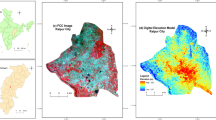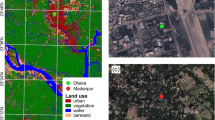Abstract
A local-scale one-dimensional model for the prediction of the thermal structure of the Planetary Boundary Layer (PBL) is presented. Time evolution of the surface-layer and whole boundary-layer thickness is considered, together with an evaluation of the energy balance at the ground. A thin transition layer (TTL) between the soil and the surface boundary layer (SL) is introduced to provide a better definition of the bottom boundary condition for temperatureT=T(t, z). Numerical tests of the model have been performed and compared with measured temperature profiles and observed surface data for two places in different seasons. The results show that the surface temperature controls the evolution of the whole profile. The bottom boundary condition is very important in the description ofT(t, z). Finally it is shown that even a simple model can give realistic results when correct values of the characteristic parameters are used.
Similar content being viewed by others
References
Acs, F., Mihailovic, D. T., and Rajkovic, B.: 1991, ‘A Coupled Soil Moisture and Surface Temperature Prediction Model’,J. Appl. Meteorol. 30, 812–822.
André, J. C., DeMoir, G., Lacarcere, P., Therry, C., and du Vachat, R.: 1978, ‘Modelling the 24-hour Evolution of the Mean and Turbulent Structures of the Planetary Boundary Layer’,J. Atmos. Sci. 35, 1862–1883.
Berkowicz, R. and Prahm, L. P.: 1982a, ‘Sensible Heat Flux Estimated from Routine Meterological Data by the Resistance Method’,J. Appl. Meteorol. 21, 1845–1864.
Berkowicz, R. and Prahm, L. P.: 1982b, ‘Evaluation of the Profile Method for Estimation of Surface Fluxes of Momentum and Heat’,Atm. Env. 16, 2809–2819.
Bhumralkar, C. M.: 1975, ‘Numerical Experiments on the Computation of Ground Surface Temperatures in an Atmospheric Circulation Model’,J. Appl. Meteorol. 14, 1246–1258.
Blackadar, A. K.: 1976, ‘Modelling the Nocturnal Boundary Layer’, Preprints of the Third Symp. on Atmospheric Turbulence, Diffusion and Air Quality, Raleigh,Amer. Meteor. Soc.
Buchan, G. D.: 1982, ‘Predicting Bare Soil Temperature. I. Theory and Models for the Multi-Day Mean Diurnal Variation’,J. Soil. Sci. 33, 185–197.
Businger, J. A.: 1973 ‘Turbulent Transfer in the Atmosphere Surface Layer’, Workshop in Micrometeorology, Chap. 2,Am. Meteorol. Soc. Boston, MA.
Carlson, T. N. and Boland, F. E.: 1978, ‘Analysis of Urban-Rural Canopy Using a Surface Heat Flux/Temperature Model’,J. Appl. Meteorol. 17, 998–1013.
Clarke, R. H.: 1971 ‘The Wangara Experiment: Boundary-Layer Data’,Div. Meteorol. Phys. Tech. Pap. 19, C.S.I.R.O. Australia.
Deardorff, J. W.: 1974, ‘Three-Dimensional Numerical Study of the Height and Main Structure of a Heated Planetary Boundary Layer’,Boundary-Layer-Meteorol. 7, 81–106.
Deardorff, J. W.: 1978, ‘Efficient Prediction of Surface Temperature and Moisture, with the Inclusion of a Layer of Vegetation,’Mon. Weather Rev. 100, 93–106.
Dickinson, R. E.: 1988, ‘The Force-Restore Model for Surface Temperature and its Generalization’,J. Climate 1, 1086–1097.
Estoque, M. A.: 1973, ‘Numerical Modelling of the Planetary Boundary Layer’, in D. A. Haugen (ed.),Workshop on Micrometeorology, Am. Meteorol. Soc. Boston, MA., pp. 217–270.
Garratt, J. R. and Hicks, B. B.: 1973, ‘Momentum, Heat, and Water Vapor Transfer to and from Natural and Artifical Surfaces’,Quart. J. Roy. Meteorol. Soc.,99, 680–687.
Jacobsen, I. and Heise E.: 1982, ‘A New Economic Method for the Computation of the Surface Temperature in Numerical Models’,Beitr. Phys. Atmosph. 55(2), 128–141.
Johnson, G. T., Oke, T. R., Lyons, T. J., Steyn, D. G., Watson, I. D., and Voogt, J. A.: 1991, ‘Simulation of Surface Urban Heat Islands Under ‘Ideal Conditions’ at Night. Part I: Theory and Tests Against Field Data’,Boundary Layer-Meteorol. 56, 275–294.
Kuo, H. L.: 1968, ‘The Thermal Interaction Between the Atmosphere and the Earth and Propagation of Diurnal Temperature Waves’,J. Atmos. Sci. 25, 682–706.
Lettau, H.: 1951, ‘Theory of Surface-Temperature and Heat-Transfer Oscillations Near a Level Ground Surface’,Trans. Am. Geophys. U. 32, 189–200.
Liou, K. N.: 1980, ‘An Introduction to Atmospheric Radiation’, Academic Press.
McCumber, M. C. and Pielke, R. A.: 1982, ‘Simulation of the Effects of Surface Fluxes of Heat and Moisture in a Mesoscale Numerical Model. Part I: Soil Layer’,J. Geophys. Res. 86, 9929–9938.
Mailhot, J. and Benoit, R.: 1982, ‘A Finite Element Model of the Atmospheric Boundary Layer Suitable for Use with Numerical Weather Prediction Model’,J. Atmos. Sci. 39, 2249–2266.
Nappo, C. J.: 1975, ‘Parameterizations of Surface Moisture and Evaporation Rate in a Planetary Boundary Layer Model’,J. Appl. Meteorol. 14, 289–296.
Novak, M. D.: 1991, ‘Application of a Mixed-Layer Model to Bare Soil Surfaces’,Boundary-Layer Meteorol. 56, 141–161.
O'Brien, J. J.: 1970, ‘A Note on the Vertical Structure of the Eddy Exchange Coefficient in the Planetary Boundary Layer’,J. Atmos. Sci. 27, 1213–1215.
Pielke, R. A.: 1984, ‘Mesoscale Meteorological Modeling’, Academic Press.
Salerno, R. and Giuliacci, M.: 1992, ‘Caratterizzazione Meteorologica del Sito di Melfi’,AMBIO-ENEL Report 92/1, Milan, Italy.
Salerno, R. and Giuliacci, M.: 1992, ‘Caratterizzazione Meteorologica del Sito di Rossano in Estate’,AMBIO-ENEL Report 93/3, Milan, Italy.
Sasamori, T.: 1968, ‘Radiative Cooling Calculation for Application to General Circulation Experiments’,J. App. Meteorol. 7, 721–729.
Sharma, L. N. and Shirvaikar, V. V.: 1976, ‘Diurnal Variation of the Surface Layer’,Boundary-Layer Meteorol. 507–511.
Stathers, R. J., Black, T. A., and Novak, M. D.: 1988, ‘Modelling Surface Energy Fluxes Temperatures in Dry and Wet Bare Soils’,Atmos.-Ocean 26, 59–73.
Yamada, T. and Mellor, G. L.: 1975, ‘A Simulation of the Wangara Atmospheric Boundary Layer Data’,J. Atmos. Sci. 32, 2309–2329
Yoshida, A. and Kunitomo, T.: 1986, ‘One-Dimensional Simulation of the Thermal Structure of Urban Atmosphere’,Int. J. Heat Mass Trans. 29, 1041–1049.
Author information
Authors and Affiliations
Rights and permissions
About this article
Cite this article
Salerno, R., Gianotti, G. A model for the evolution in rural areas of the temperature profile in the boundary layer and a comparison with measured data. Boundary-Layer Meteorol 73, 255–278 (1995). https://doi.org/10.1007/BF00711259
Revised:
Issue Date:
DOI: https://doi.org/10.1007/BF00711259




